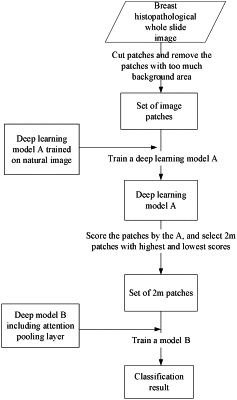| CPC G06F 18/2148 (2023.01) [G06F 18/241 (2023.01); G06N 20/00 (2019.01); G06T 7/0012 (2013.01); G06T 7/194 (2017.01); G06T 2207/20081 (2013.01); G06T 2207/20084 (2013.01); G06T 2207/30068 (2013.01)] | 9 Claims |

|
1. An end-to-end attention pooling-based classification method for histopathology images, comprising the following steps:
S1, cutting a histopathological whole slide image into square patches with a side length L, pre-processing to filter patches, and packaging the remaining patches into a bag;
S2, modifying the last fully connected layer in a pre-trained Resnet50 network, recording the modified model as A, and training the model A by a standard multi-instance learning method;
S3, scoring all the patches by using the trained model A, and selecting m patches with highest and lowest scores for each image to form a new bag;
S4, building a deep learning model B comprising an attention pooling module, and training the model B by using the new bag obtained in S3; and
S5, after a bag containing 2 m patches is obtained by processing the histopathology image to be classified in S1 and S3, classifying the bag by using the model B trained in S4, wherein the classification result is the final classification result of the image to be classified.
|